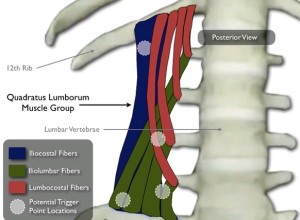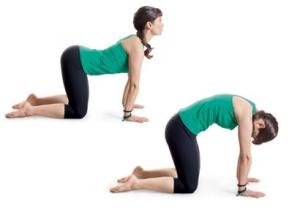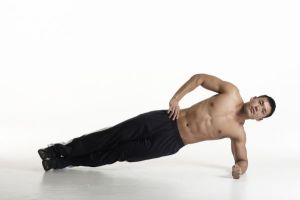The Quadratus Lumborum has its origin on the medial or inside part of the 12th rib. It inserts on the posterior crest of the ilium. If you put your hands on your hips, your thumbs while resting on top of the hip will be close to the insertion point. The muscle is also linked to the transverse processes of the lower spine. 
Pain emanating from the muscle can be describes as a deep ache in the lower back through to a sharp, knife like pain. People will often place their hands on their hips as a way of bracing the area.
The muscle is used when you bend to the side. Place your left hand between your hip and lowest rib. Now bend to your right. You will feel the muscle go into a stretch. The muscle also helps stabilize the hip as you balance on one leg. A fully functioning QL is thus critical for any runner.
The QL muscle also assists with breathing as it provides a direct extension of the diaphragm to the pelvis and can inhibit deep breathing in the back if it is too tight or fascially short. Released & relaxed QL muscles help you breath more efficiently and hence perform better.
The quadratus lumborum is a tricky muscle to release and is one of the muscles most overlooked in massage. One often picks up a disparity between the left and right hand side. One side often tightens more than the other. This has the effect of shortening the gap between the ribs and hip on the one side of the body and thus unbalancing the lower back and hip.
Releasing the muscle is fairly complex with work needed on the attachment at the 12th rib and crest of the ilium. The belly of the muscle often responds well to cross friction.
Runners, cyclists and swimmers all run the risk of the muscle tightening up. This tightness can present as a sense of tiredness and discomfort in the lower back.
Swimmers will shorten the muscle as they pull their hips up while swimming. It is also possible to tighten the one side more than the other if you breathe on one side only while in the water.
Cyclists can place strain on the muscle with bad bike setups and also by ‘rowing’ on the handlebars while cycling uphill.
Runners can put strain on the muscle due to their hips rocking while they run. This is exacerbated if their glute medius muscle is weak. You can read more about this process here – https://sbrsport.wordpress.com/2012/11/25/weak-gluteus-medius-muscles-and-a-chain-reaction/
Other things that can cause a QL event include sneezing, running on cambered roads, lifting heavy objects, bending awkwardly, putting pants on and a soft sagging mattresses. Bottom line; be careful, it’s a jungle out there.
Some exercises that you can do include cat and cow poses and side planks. 

Chinese medicine has always associated lower back pain with people who have been exposed to cold and damp weather. Their suggestion is to treat the muscle with warmth. I concur with that.
I have found that a number of athletes have QLs that are full of trigger points and tight. Lots of people are quite surprised just how tight the muscle gets. There is often a huge sigh of relief after the muscle has been released. I have also found that many suffeing with painful illiotibial bands have shortened QL muscles.
Most back pain is temporary and comes from a muscle that has gone into a spasm. However, there are a number of things that can go wrong with the spine. If in doubt check it out with your GP.
Regards,
Mike Roscoe.
Kinesiologist.


Pingback: Muscles used in breathing. | SBR Sport
Pingback: Happy & Healthy Hips. | SBR Sport